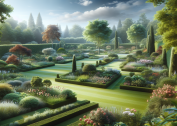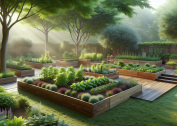Explore how simple energy efficient home upgrades transform comfort, cut costs, and benefit the environment. This guide reveals practical ideas and the science behind insulation, lighting, smart thermostats, and sustainable landscaping. Learn how others are making their home and garden greener with these actionable tips.
The Impact of Home Insulation on Energy Savings
Ensuring proper home insulation is the backbone of any energy efficient home upgrade strategy. Insulation in attics, walls, and floors effectively reduces heat flow, keeping houses warmer during colder months and cooler throughout summer. Homeowners often notice lower utility bills and improved indoor comfort when their home is adequately sealed and insulated. Proper insulation also lessens the strain on HVAC systems, thereby supporting long-term savings and prolonging equipment lifespan. Studies suggest attic insulation can save up to 15% on heating and cooling expenses compared to uninsulated or poorly insulated spaces (https://www.energy.gov/energysaver/insulation).
Evaluating insulation options can get technical. Choices include fiberglass batts, blown-in cellulose, rigid foam boards, and spray foam. Each material suits different climates and home styles. Professionals recommend checking your home’s R-value—a measurement of insulation’s effectiveness—when considering upgrades. Generally, higher R-values mean better thermal resistance. Local utility providers or energy auditors can help homeowners determine if their existing insulation meets current recommendations and identify opportunities to improve energy efficiency even further.
One detail that sometimes gets overlooked is insulation around ducts, pipes, and crawl spaces. These areas can act as hidden gateways for energy loss. Sealing and insulating around these features can deliver a surprising boost in energy performance. Homeowners interested in maximizing cost savings and comfort often tackle these small projects alongside major upgrades, optimizing the home’s envelope for year-round efficiency. A comprehensive approach turns insulation into a powerful home improvement investment.
Smart Thermostats: Why They Change the Game
Smart thermostats increasingly feature in conversations about affordable home energy solutions. These devices go far beyond traditional manual controls. By using sensors, schedules, and Wi-Fi connectivity, smart thermostats adjust temperature settings automatically based on occupancy, time of day, and even local weather forecasts. Many models let users monitor and tweak their home’s climate from a mobile app, allowing for even greater control and personalization without sacrificing comfort.
The biggest benefit is energy management. Smart thermostats help prevent wasteful heating and cooling when rooms are empty. They ‘learn’ household routines and can create cost-saving schedules. Some utilities even offer rebates for installing select smart thermostats, making switching more affordable. Beyond convenience, these devices generate reports letting residents track usage patterns and identify opportunities for ongoing improvement. This empowers people to make smarter choices without constant manual adjustment (https://www.energy.gov/energysaver/programmable-thermostats).
Integration is another advantage. Many smart thermostats sync with other smart home devices, like voice-activated speakers or whole-home energy systems. Over time, households with even a single smart thermostat often experience significant reductions in their energy costs—sometimes 8% or more in heating and cooling savings. Such upgrades prove that comfort and efficiency can coexist. For those interested in sustainable home improvements, this is one of the most accessible and cost-effective starting points.
LED Lighting and Its Long-Term Impact
Making the switch to LED lighting is a straightforward way to cut down on household energy use. Compared to traditional incandescent or compact fluorescent bulbs, LEDs use up to 75% less energy while lasting considerably longer. Homeowners who retrofit their lighting often notice instant reductions in power consumption on their electricity bills, proving that small changes add up quickly—especially in larger homes with many fixtures (https://www.energy.gov/energysaver/save-electricity-and-fuel/lighting-choices-save-you-money/led-lighting).
LEDs are versatile. They are now available in a wide range of brightness levels and colors, suitable for every room or outdoor space. The adaptability makes them a favorite for creative landscaping or accent lighting projects. Additionally, LED bulbs don’t give off as much excess heat, which can help maintain a comfortable indoor temperature and reduce the strain on air conditioning systems during hotter months. Replacing outdated lighting is a quick project that brings cumulative results through energy savings.
Long-term cost effectiveness is another key consideration. Although the upfront cost for LED bulbs is higher than conventional options, their extended lifespan—often lasting over a decade—means homeowners replace them infrequently and avoid ongoing expenses. Combined with the energy savings, many people recoup the investment within a year or two. For those interested in lowering household carbon footprints, LEDs serve as both an eco-friendly and budget-wise upgrade suitable for homes and gardens alike.
Water Conservation Tips for Inside and Outside
Modernizing a home’s water efficiency delivers multiple benefits: lower water bills, reduced energy use, and an eco-friendly impact. Installing low-flow fixtures—like toilets, faucets, and showerheads—minimizes water consumption without changing the user experience. Many homeowners are surprised to discover these upgrades maintain strong performance while reducing overall water use by as much as 30%, which can mean substantial monthly savings (https://www.epa.gov/watersense).
Water conservation also extends to outdoor landscapes. Switching to drought-resistant plants, known as xeriscaping, helps create a garden that thrives on minimal irrigation. Mulching garden beds further retains soil moisture, reducing how often watering is necessary. Smart irrigation systems that deliver precise amounts of water at optimal times enhance the process and prevent overwatering. These simple changes can help gardens stay healthy while keeping resource use in check.
Some homeowners take water management to the next level by installing rain barrels or greywater systems. These solutions repurpose naturally occurring or previously used water for gardens and lawns, lessening reliance on municipal supplies. Combined with mindful lawn care, such as mowing high and watering in the early morning, residents can optimize water conservation without sacrificing curb appeal or gardening enjoyment. Sustainability starts with these small, replicable shifts.
Sustainable Landscaping and Eco-Friendly Gardening
Eco-friendly gardening isn’t just a trend—it’s a fundamental way to create beautiful outdoor spaces that support biodiversity and resource conservation. Planting native shrubs and wildflowers offers important food and shelter for local pollinators and birds. Using organic mulches and compost returns nutrients to the soil naturally, eliminating the need for chemical fertilizers and minimizing the environmental impact on surrounding areas (https://www.nwf.org/Garden-for-Wildlife/About).
Design also matters. Permeable surfaces for driveways and walkways, like gravel or pavers, allow rainwater to seep into the ground rather than run off, reducing erosion and stormwater problems. Thoughtful placement of shade trees can lower home cooling costs by blocking the sun in summer, while deciduous trees lose their leaves to let in warming sunlight during winter. These design techniques lower utility bills while enhancing year-round enjoyment of the garden.
Incorporating sustainable landscaping into daily life brings a sense of stewardship. Many homeowners share stories of increased wildlife visits, seasonal color changes, and lower overall costs after making eco-conscious updates. Grouping plants with similar water and sunlight needs together ensures efficient care. Over time, sustainable gardening practices turn regular yards into thriving, resilient habitats that provide lasting benefits to people, wildlife, and the environment.
Weatherization and Air Sealing Strategies
Weatherization goes hand in hand with energy efficient home upgrades. The process involves sealing leaks around doors, windows, and foundations to prevent unwanted air exchange. Even minor gaps can result in noticeable drafts and rising utility costs. Energy audits frequently highlight air sealing as a top priority for boosting overall efficiency. Households who invest in weatherstripping and caulking often notice enhanced comfort and immediate reductions in their monthly energy spend (https://www.energy.gov/energysaver/weatherize/weatherization).
Energy auditors use specialized tools like blower doors and infrared cameras to track down the most problematic leaks. Once identified, remedies are usually simple, such as adding foam gaskets behind outlets or using spray foam insulation for larger voids. Weatherization tends to offer a rapid return on investment, especially in older homes that haven’t benefited from more recent construction standards.
Combining air sealing with adequate insulation amplifies results. Homeowners who address both at once often report higher satisfaction and lower ongoing maintenance needs. Improved indoor air quality is another benefit. By reducing drafts and outside contaminants, weatherization supports cleaner, healthier living spaces. This passive yet powerful upgrade makes any home feel cozier and perform more efficiently year round.
References
1. U.S. Department of Energy. (n.d.). Insulation. Retrieved from https://www.energy.gov/energysaver/insulation
2. U.S. Department of Energy. (n.d.). Programmable Thermostats. Retrieved from https://www.energy.gov/energysaver/programmable-thermostats
3. U.S. Department of Energy. (n.d.). LED Lighting. Retrieved from https://www.energy.gov/energysaver/save-electricity-and-fuel/lighting-choices-save-you-money/led-lighting
4. U.S. EPA. (n.d.). WaterSense. Retrieved from https://www.epa.gov/watersense
5. National Wildlife Federation. (n.d.). Garden for Wildlife. Retrieved from https://www.nwf.org/Garden-for-Wildlife/About
6. U.S. Department of Energy. (n.d.). Weatherization. Retrieved from https://www.energy.gov/energysaver/weatherize/weatherization









